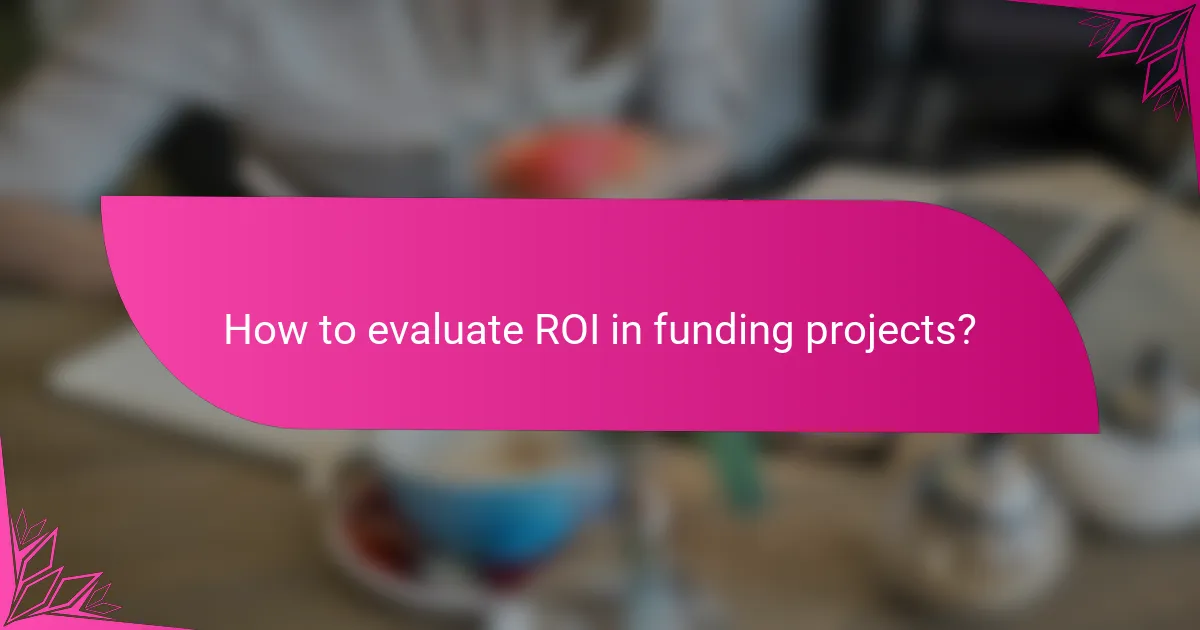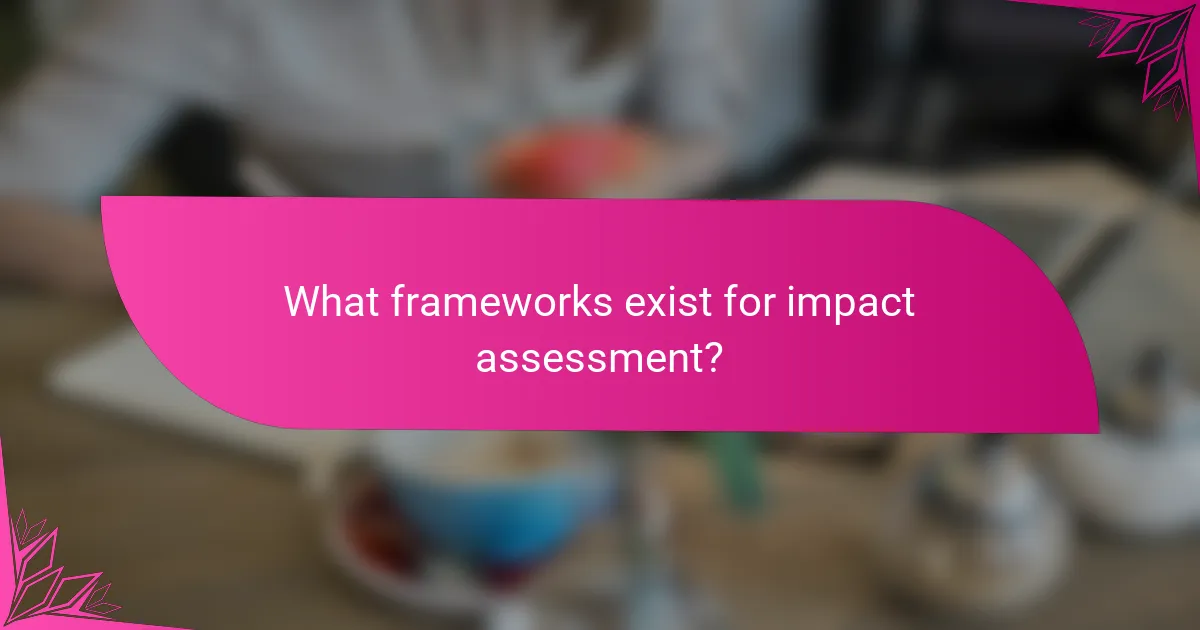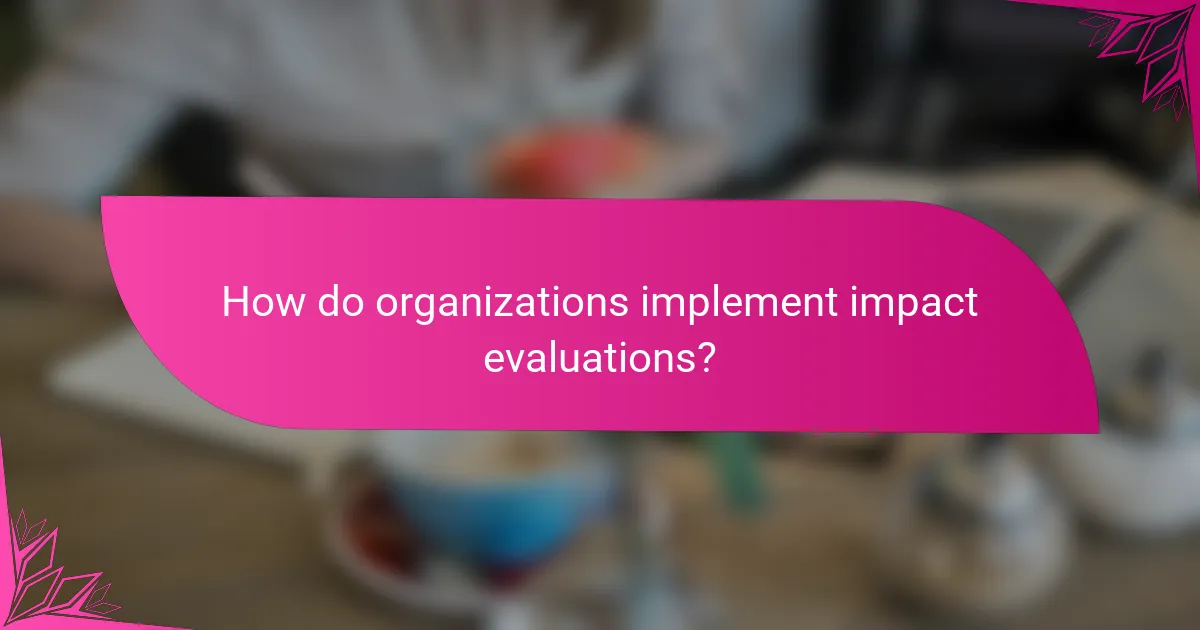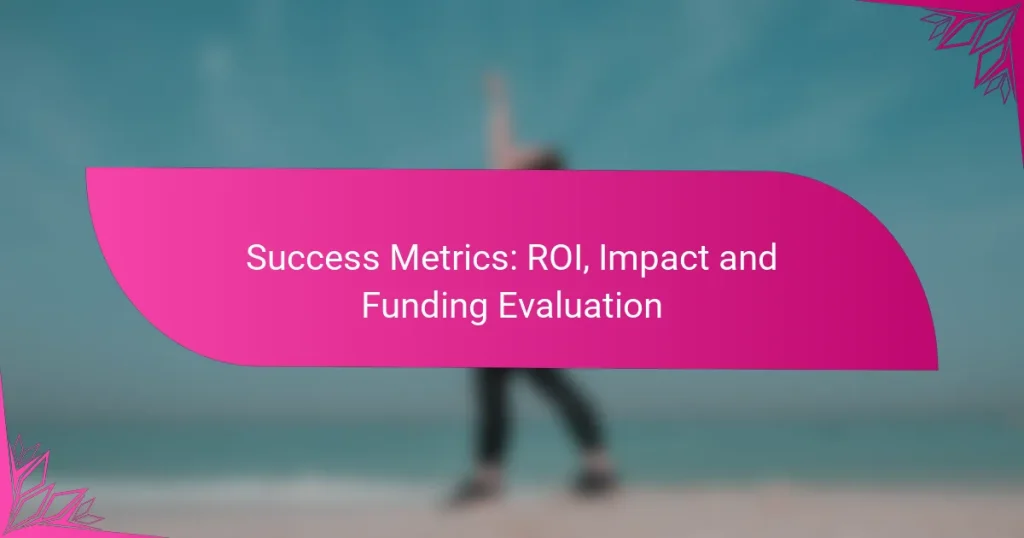Success metrics play a crucial role in evaluating the effectiveness of funding projects, focusing on key indicators such as return on investment (ROI) and impact assessments. By analyzing financial returns relative to investments, organizations can make informed decisions about future funding and project sustainability. Additionally, quantifiable impact metrics, including social return on investment (SROI) and stakeholder engagement, provide valuable insights into the overall effectiveness and value of initiatives.

How to evaluate ROI in funding projects?
Evaluating ROI in funding projects involves assessing the financial return relative to the investment made. This process helps determine the effectiveness and sustainability of the project, guiding future funding decisions.
Financial metrics analysis
Financial metrics analysis focuses on quantifying the monetary benefits derived from a project. Key metrics include net present value (NPV), internal rate of return (IRR), and payback period. For instance, a project with an NPV greater than zero typically indicates a profitable investment.
When analyzing financial metrics, consider both direct and indirect costs. Direct costs are easily quantifiable, while indirect costs may include factors like opportunity costs or potential reputational impacts. A comprehensive analysis should account for both to provide a clearer picture of ROI.
Benchmarking against industry standards
Benchmarking involves comparing a project’s ROI against industry standards to gauge its performance. This process helps identify whether a project is underperforming or exceeding expectations. For example, if the average ROI in a sector is around 15%, a project yielding 20% would be considered successful.
Utilizing industry reports and databases can facilitate effective benchmarking. Look for relevant metrics specific to your industry, such as average funding returns or project success rates, to ensure accurate comparisons.
Case studies of successful projects
Case studies provide valuable insights into successful projects and their ROI evaluations. Analyzing real-world examples can highlight effective strategies and common pitfalls. For instance, a technology startup that secured funding and achieved a 30% ROI within two years can serve as a model for similar ventures.
When reviewing case studies, focus on the methodologies used for ROI calculation and the factors contributing to success. This can include innovative approaches, market conditions, or effective stakeholder engagement, which can inform your own funding project evaluations.

What impact metrics should be considered?
When evaluating impact metrics, organizations should focus on quantifiable measures that reflect the effectiveness and value of their initiatives. Key metrics include social return on investment (SROI), long-term sustainability indicators, and stakeholder engagement outcomes, each providing insights into different aspects of impact.
Social return on investment (SROI)
Social return on investment (SROI) measures the social, environmental, and economic value created by an initiative relative to the resources invested. It helps organizations understand the broader impact of their work beyond financial returns. A common approach is to calculate SROI by comparing the net benefits to the total investment, often expressed as a ratio.
To effectively use SROI, organizations should gather data on both quantitative and qualitative outcomes. For example, if a community program costs $100,000 and generates $300,000 in social value, the SROI would be 3:1. This metric can guide funding decisions and improve resource allocation.
Long-term sustainability indicators
Long-term sustainability indicators assess the ongoing viability and resilience of a project or organization. These metrics can include financial health, environmental impact, and social equity, which collectively determine the sustainability of initiatives over time. Organizations should track these indicators to ensure they are not only achieving short-term goals but also contributing to lasting change.
Common indicators include revenue growth, cost efficiency, and community involvement levels. For instance, a nonprofit might monitor its percentage of funding from diverse sources to reduce reliance on a single donor, enhancing its sustainability. Regularly reviewing these indicators helps organizations adapt and thrive in changing environments.
Stakeholder engagement outcomes
Stakeholder engagement outcomes measure the effectiveness of an organization’s interactions with its stakeholders, including beneficiaries, funders, and community members. These outcomes reflect how well an organization communicates, collaborates, and builds trust with its stakeholders. High levels of engagement can lead to better program design and increased support.
To evaluate stakeholder engagement, organizations can use surveys, feedback sessions, and participation rates in events. For example, if a program sees a 50% increase in stakeholder participation over a year, it indicates improved engagement. Organizations should prioritize open communication and responsiveness to stakeholder needs to enhance these outcomes.

How to measure funding effectiveness?
Measuring funding effectiveness involves evaluating how well financial resources contribute to desired outcomes. Key metrics include return on investment (ROI), impact assessments, and overall funding efficiency.
Cost-benefit analysis
Cost-benefit analysis (CBA) is a systematic approach to estimating the strengths and weaknesses of alternatives in terms of costs and benefits. This method helps organizations determine whether the financial benefits of a project outweigh its costs, providing a clear picture of funding effectiveness.
To conduct a CBA, list all costs associated with the funding, including direct expenses and indirect costs, and compare them to the anticipated benefits, which can be financial gains or social impacts. For example, if a project costs $100,000 but is expected to generate $150,000 in revenue, the CBA indicates a positive return.
Performance tracking tools
Performance tracking tools are essential for monitoring the effectiveness of funding over time. These tools can include software applications, dashboards, and reporting systems that provide real-time insights into project performance against set goals.
Utilizing key performance indicators (KPIs) allows organizations to measure progress quantitatively. For instance, tracking metrics such as project completion rates, user engagement levels, or financial returns can help identify areas needing improvement and ensure that funding is being used effectively.
Comparative funding models
Comparative funding models involve analyzing different funding structures to determine which is most effective for achieving specific goals. Common models include grants, loans, and equity financing, each with distinct advantages and disadvantages.
For example, grants may provide non-repayable funds that can be beneficial for non-profit initiatives, while loans may offer lower interest rates for projects with clear revenue potential. Evaluating these models against the desired outcomes helps organizations choose the best funding approach for their needs.

What are the best practices for funding evaluation?
Best practices for funding evaluation focus on establishing clear objectives, leveraging data analytics, and maintaining regular reporting. These practices ensure that funding decisions are informed, transparent, and aligned with strategic goals.
Establishing clear objectives
Clear objectives are essential for effective funding evaluation. They provide a framework for assessing the success of funded projects and help stakeholders understand expected outcomes. Objectives should be specific, measurable, achievable, relevant, and time-bound (SMART).
For example, instead of a vague goal like “improve community health,” a clear objective might state, “increase the number of health screenings by 30% within one year.” This specificity allows for better tracking and evaluation of progress.
Utilizing data analytics platforms
Data analytics platforms play a crucial role in funding evaluation by enabling the collection and analysis of relevant data. These tools can help organizations track performance metrics, identify trends, and make data-driven decisions. Popular platforms include Tableau, Power BI, and Google Analytics.
When selecting a data analytics platform, consider factors such as ease of use, integration capabilities, and cost. A well-chosen platform can streamline the evaluation process and enhance the accuracy of insights derived from the data.
Regular reporting and feedback loops
Regular reporting and feedback loops are vital for ongoing funding evaluation. They ensure that stakeholders remain informed about project progress and outcomes, allowing for timely adjustments if necessary. Establishing a schedule for reporting—such as quarterly or biannual updates—can foster accountability.
Incorporating feedback from stakeholders can also enhance evaluation efforts. This can be achieved through surveys, interviews, or focus groups, providing valuable insights that inform future funding decisions and project improvements.

What frameworks exist for impact assessment?
Several frameworks for impact assessment help organizations evaluate their effectiveness and return on investment. These frameworks provide structured approaches to measure outcomes, enabling better decision-making and resource allocation.
Logic model framework
The logic model framework visually represents the relationship between resources, activities, outputs, and outcomes. It typically includes inputs, processes, outputs, and short-, medium-, and long-term outcomes, allowing stakeholders to understand how activities lead to desired impacts.
To create a logic model, start by identifying the inputs (resources), then outline the activities and expected outputs. Finally, define the outcomes, ensuring they are measurable and time-bound. This clarity helps in tracking progress and making necessary adjustments.
Theory of change approach
The theory of change approach outlines the steps necessary to achieve a specific goal, detailing the assumptions behind each step. It emphasizes the causal pathways that connect activities to outcomes, making it easier to identify what works and what doesn’t.
When developing a theory of change, engage stakeholders to clarify the desired impact and the necessary preconditions. This collaborative process helps ensure that the assumptions are realistic and grounded in evidence, increasing the likelihood of successful implementation.
Balanced scorecard method
The balanced scorecard method evaluates performance from multiple perspectives: financial, customer, internal processes, and learning and growth. This holistic view helps organizations align their activities with their strategic objectives and measure success beyond just financial metrics.
To implement a balanced scorecard, define key performance indicators (KPIs) for each perspective. Regularly review these metrics to assess progress and make informed adjustments. This method encourages a well-rounded approach to performance management, fostering continuous improvement.

How do organizations implement impact evaluations?
Organizations implement impact evaluations by systematically assessing the effectiveness of their programs and initiatives. This process involves defining clear objectives, collecting relevant data, and analyzing outcomes to determine the overall impact and return on investment.
Step-by-step evaluation process
The evaluation process typically begins with setting specific goals and objectives that the program aims to achieve. Next, organizations should develop a logic model that outlines the expected inputs, activities, outputs, and outcomes. This framework helps in identifying the key metrics to measure.
Data collection follows, which can involve surveys, interviews, and existing records. It’s crucial to choose appropriate methods that align with the evaluation goals. After gathering data, organizations analyze the results to assess the program’s effectiveness, often using statistical methods to ensure reliability.
Finally, organizations should communicate the findings to stakeholders and use the insights gained to inform future decisions. Regularly revisiting and refining the evaluation process can enhance its effectiveness over time.
Engaging stakeholders in evaluations
Engaging stakeholders is essential for successful impact evaluations, as their insights can shape the evaluation design and ensure relevance. Stakeholders may include program participants, funders, and community members who provide valuable perspectives on the program’s impact.
To effectively engage stakeholders, organizations should involve them early in the evaluation process. This can be done through workshops or focus groups where stakeholders can share their expectations and concerns. Maintaining open communication throughout the evaluation helps build trust and encourages ongoing collaboration.
Additionally, organizations should consider stakeholder feedback when interpreting results and making recommendations. This inclusive approach not only enhances the evaluation’s credibility but also fosters a sense of ownership among stakeholders, increasing the likelihood of implementing suggested improvements.


